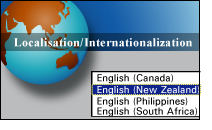ARCHIVÉE 4.9.2. Localization and Internationalization
Contenu archivé
L’information dite archivée est fournie à des fins de référence, de recherche ou de tenue de documents. Elle n’est pas assujettie aux normes Web du gouvernement du Canada et n’a pas été modifiée ni mise à jour depuis son archivage. Pour obtenir cette information dans un autre format, Contactez-nous.
Consulter le Pavel en ...
Español Português Italiano Nederlands العربية
 In a world of global markets, the language industries are working to increase productivity and reduce waste by promoting sharing, re-use and recycling of language resources to help reach people around the world, no matter their language or culture. When companies and people wish to communicate to other companies and people, the most effective way to be understood is to use the other person’s language, including the other person’s terminology.
In a world of global markets, the language industries are working to increase productivity and reduce waste by promoting sharing, re-use and recycling of language resources to help reach people around the world, no matter their language or culture. When companies and people wish to communicate to other companies and people, the most effective way to be understood is to use the other person’s language, including the other person’s terminology.
Localization
Localization is the process of tailoring your communication for a particular cultural group. Esselink, speaking of software localization, defines it as "the process of adapting and translating a software application into another language in order to make it linguistically and culturally appropriate for a particular local market." (Esselink 1998: 2) For example, if a spell checker offers you the options English-New Zealand or French-Switzerland, it has been localized to reflect local language use, culture and customs.
A simple example of the need for localization in English would be an American company that sells what in North America are called "chips" deciding to sell its product in the United Kingdom. If the company does not localize its packaging to read "crisps" instead of "chips" the consumer overseas will be expecting to open the bag and find what a North American would call "french fries." The company might not sell many units if consumers felt disappointed or confused by the "misleading" labelling on the bag.
Internationalization
Internationalization is the process of readying a communication (for example, Web page, software interface, or magazine advertisement) for localization into multiple languages by creating a language-free, culturally abstracted template into which content in various languages can be integrated. Esselink, also in the context of software localization, talks about it as designing software "in a way to allow for translation into other languages without the need for re-design or re-compilation. An important aspect of internationalization is the separation of text and source code." (Esselink 1998: 1)
While the previous example explains the need for correct terminology, there is more than terminology to keep track of with internationalization. If anything you do includes a date and time, you’ll need to be aware of the fact that not everyone uses the same method of marking time. Some use a 12-hour clock (3:00 p.m.), some a 24-hour clock (0800 hours). You cannot even assume that the year will be the same everywhere. Not only must you be aware of the format differences, but you must also consider the space it takes for the information. For instance, if you ask for someone’s zip code (generally five digits in the United States) in a form, do NOT give them a field five characters long to fill in and only allow them to insert numbers. If you do, you will make it impossible for many people in southern California to provide you the information you need because their postal codes have nine digits. This could be vital delivery information. In doing so you would also cause problems for people from Canada, Australia, New Zealand or the United Kingdom, because not only are their postal codes six characters long, often with a space, but they use letters as well as numbers. If you fail to allow for at least seven alphanumeric characters, at best you could be making things difficult for potential customers. At worst, you could be offending them, making them feel like you do not respect them.
- Date de modification :